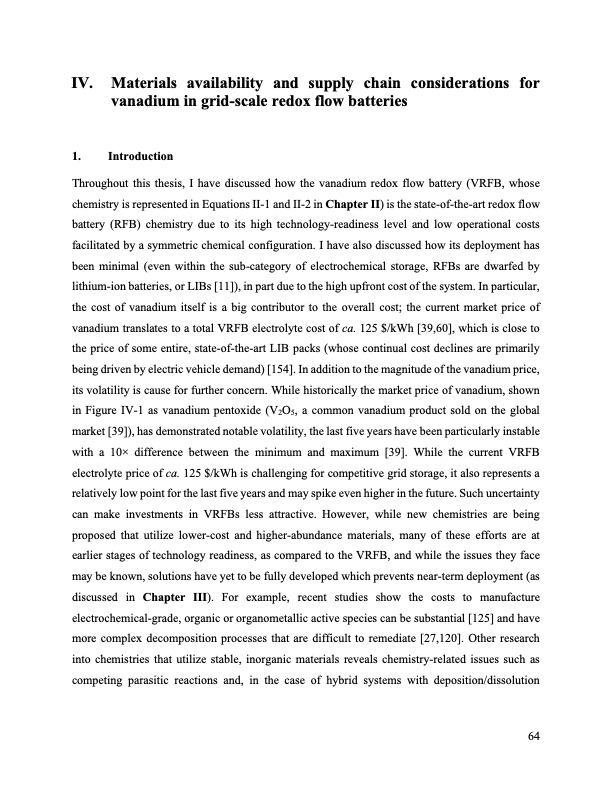
PDF Publication Title:
Text from PDF Page: 064
IV. Materials availability and supply chain considerations for vanadium in grid-scale redox flow batteries 1. Introduction Throughout this thesis, I have discussed how the vanadium redox flow battery (VRFB, whose chemistry is represented in Equations II-1 and II-2 in Chapter II) is the state-of-the-art redox flow battery (RFB) chemistry due to its high technology-readiness level and low operational costs facilitated by a symmetric chemical configuration. I have also discussed how its deployment has been minimal (even within the sub-category of electrochemical storage, RFBs are dwarfed by lithium-ion batteries, or LIBs [11]), in part due to the high upfront cost of the system. In particular, the cost of vanadium itself is a big contributor to the overall cost; the current market price of vanadium translates to a total VRFB electrolyte cost of ca. 125 $/kWh [39,60], which is close to the price of some entire, state-of-the-art LIB packs (whose continual cost declines are primarily being driven by electric vehicle demand) [154]. In addition to the magnitude of the vanadium price, its volatility is cause for further concern. While historically the market price of vanadium, shown in Figure IV-1 as vanadium pentoxide (V2O5, a common vanadium product sold on the global market [39]), has demonstrated notable volatility, the last five years have been particularly instable with a 10× difference between the minimum and maximum [39]. While the current VRFB electrolyte price of ca. 125 $/kWh is challenging for competitive grid storage, it also represents a relatively low point for the last five years and may spike even higher in the future. Such uncertainty can make investments in VRFBs less attractive. However, while new chemistries are being proposed that utilize lower-cost and higher-abundance materials, many of these efforts are at earlier stages of technology readiness, as compared to the VRFB, and while the issues they face may be known, solutions have yet to be fully developed which prevents near-term deployment (as discussed in Chapter III). For example, recent studies show the costs to manufacture electrochemical-grade, organic or organometallic active species can be substantial [125] and have more complex decomposition processes that are difficult to remediate [27,120]. Other research into chemistries that utilize stable, inorganic materials reveals chemistry-related issues such as competing parasitic reactions and, in the case of hybrid systems with deposition/dissolution 64PDF Image | Bringing Redox Flow Batteries to the Grid

PDF Search Title:
Bringing Redox Flow Batteries to the GridOriginal File Name Searched:
Rodby-krodby-phd-chemE-2022-thesis.pdfDIY PDF Search: Google It | Yahoo | Bing
Salgenx Redox Flow Battery Technology: Salt water flow battery technology with low cost and great energy density that can be used for power storage and thermal storage. Let us de-risk your production using our license. Our aqueous flow battery is less cost than Tesla Megapack and available faster. Redox flow battery. No membrane needed like with Vanadium, or Bromine. Salgenx flow battery
| CONTACT TEL: 608-238-6001 Email: greg@salgenx.com | RSS | AMP |